Recent Volunteer Insights
Ann-Kathrin and Daniel, from Germany, spent a month volunteering with us back in July-August, here they share their experiences and insights of our volunteer programme and the work we do.
“After arriving in Toliara at the end of the beautiful Route Nationale 7, we headed straight for Reef Doctor, about 25 km north, for a month of volunteering in the small village of Ifaty in the Bay of Ranobe. Reef Doctor (RD) is an NGO and, as the name suggests, its primary goal is to conserve marine life. RD wants to achieve this by active marine research and conservation, but also, and probably much more important, by educating the communities and creating sustainable livelihoods for the people in the Bay of Ranobe.
In this blog we would like to focus on our time at Reef Doctor and some the projects we were involved in.
Reef Doctor site
RD is located on the beach in Ifaty, which lies in the Bay of Ranobe. The living conditions here are very basic, but it is such a beautiful site!

Reef conservation and artificial reefs
Some of the main projects conducted by RD involve diving. There are now two marine protected areas in the Bay of Ranobe that were established by RD in collaboration with the local fishermen’s association. This was a long and strenuous process because you have to convince the locals that it is actually good for them to stop fishing in certain areas. The main protected area where RD operates is called Rose Garden. The edges of this reef are quite damaged, but in parts you can still see how amazing the whole site once must have been and will surely be again in the future.
Next to the Rose Garden reef, RD installed a coral table which acts as a nursery for corals. During our time at RD we collected coral pieces from an unprotected area that were fragmented due to natural reasons, fishing with nets, or probably even by snorkelers or divers, and brought them up to the boat. There we superglued them to dead pieces of coral and then transported them to the nursery table, where they were attached and left to grow. The crucial part is the superglue, because corals have to be firmly attached to something to be able to grow and the process is very slow. In exchange for the newly added corals, we took corals that were already strong and big enough off the table and transplanted them onto rocks on the reef with epoxy putty (used in plumbing and in aquariums) that hardens within 24 hours and keeps the coral stable on the rock.
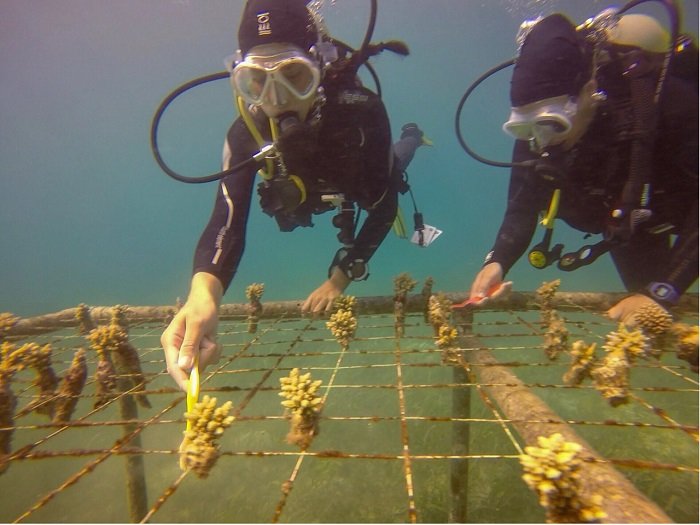

In parallel, in a collaboration with the villagers, stones have been sourced, brought out with pirogues and placed on the seabed. The volunteers and staff at RD then organised the rocks to create an artificial reef where marine life can find a new home. These artificial reef structures are supplemented with concrete dome-shaped habitat enhancement structures with lots of holes to attract even more marine life, specifically juvenile fish and invertebrates. In the long run, the artificial reef sites should take the pressure off the established and overfished fishing grounds.
Dive training and marine research
While working at RD, volunteers are able to begin or continue their dive training. We completed our Advanced Open Water Diver, others started with the Open Water Diver or even Dive Master. But there is more! All volunteers receive science training comprising a lecture series and training in identification of fish, invertebrates and benthic composition. Completing this training to the indicator level (there is also an expert level with more species) enabled us to actively participate in coral reef surveys. By doing so, we helped provide information on the health and status of the reef. For the protected areas, the prognosis quite good. The conservation efforts are making a difference! Yay!


Fisheries
To have an idea about how much the people in the area fish and which gear they use, RD performs regular assessments of catches and fishing efforts in different villages. It is a very interesting to participate in one of these surveys, to see the pirogues with their beautiful sails coming home and being crowded by people who want to be the first to buy some fish. But it is also sad to see the many exotic and rare fish and invertebrates (e.g., squid or octopus) that the people catch. The only fish locals won’t eat are poisonous ones. If a shark or even a dolphin finds their way into the bay, you can be sure it will be found on the market very soon after.
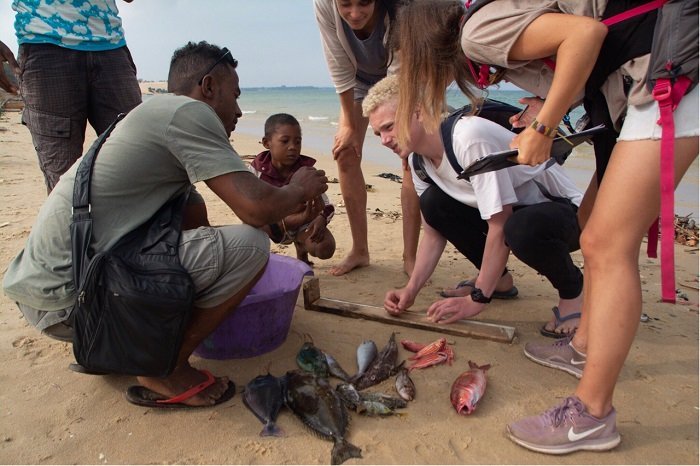
RD is trying to control catches of marine turtles with a tagging project: fishermen are paid for every turtle caught under a certain size and brought to the RD site. Here, it is measured and tagged and then the fishermen can release it again where they found it and get a cash reward for it. This worked quite well while we were there and roughly 3-4 turtles per week were brought in. While this surely helps to protect young turtles, there are wider issues still needing to be tackled concerning adults.
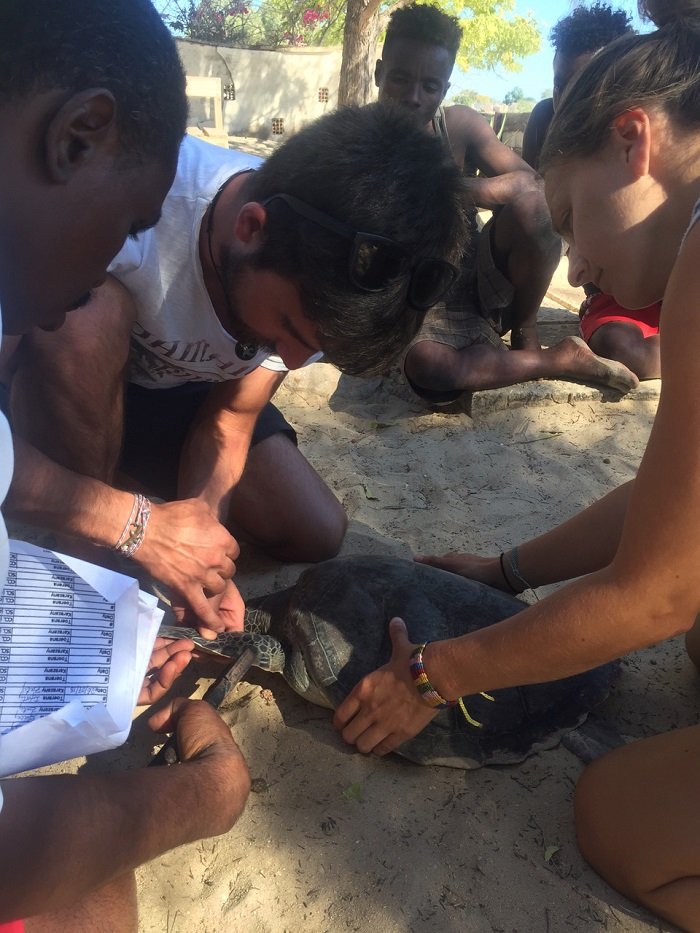
Aquaculture
To further reduce fishing pressure, RD is trying to establish alternative livelihood projects with the villagers. There are several aquaculture projects, such as pisciculture, and growing seaweed or sea cucumbers for the Chinese market. Farming seaweed also has the fantastic side effect of providing a perfect nursery habitat for juvenile fish, undisturbed by fishing. Furthermore, in collaboration with Indian Ocean Trepang (IOT) in Toliara, RD helps provide selected villagers from Ambalomailake or Andrevo with juvenile sea cucumbers. IOT is specialised in breeding sea cucumbers and agreed to provide juveniles to locals who then let them grow in enclosed pens. When they reach a certain size, they can sell them for a profit and give a percentage of the money back to IOT. This enables the sea cucumber farmers to generate an extra income to fishing.
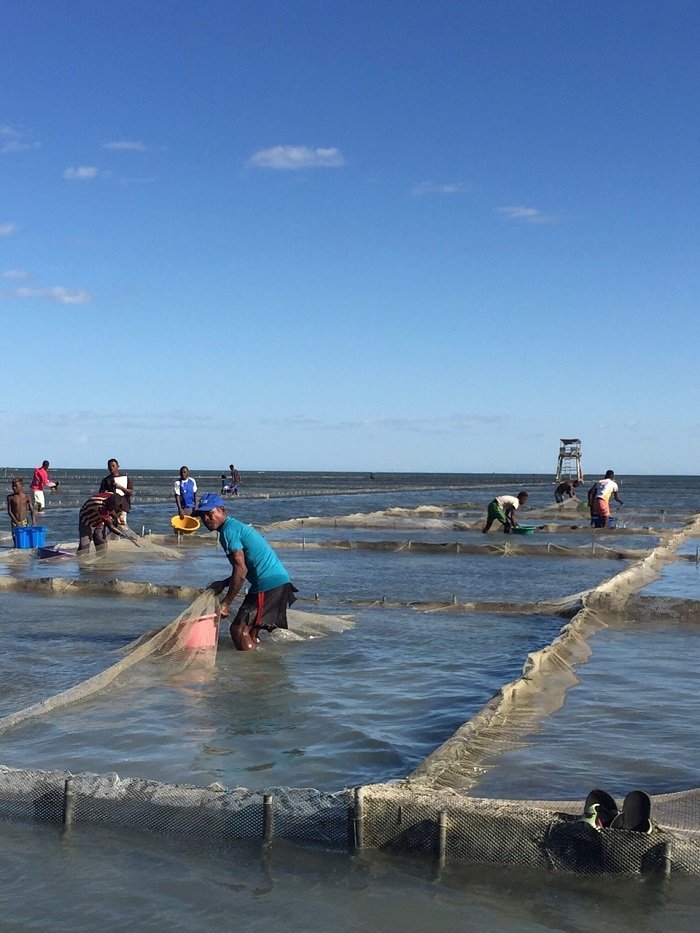
Protecting mangrove trees at Honko
Mangroves are a very important habitat for marine life. These coastal trees have several functions benefitting the reefs. They provide a perfect habitat for juvenile fish, they filter the water and improve its quality, and they protect the coast from erosion which reduces sedimentation on the reef. Honko means mangrove in Malagasy and at the Honko site, RD manages a protected area for mangroves that were in the past cut down by people to make coal (which is the primary material for cooking) or simply to make space for reeds, which can be used for building houses and roofs, or for use as a salt pan. The protected site offers guided tours and canoe trips through the mangroves. When we were there measured replanted mangroves and analyzed how much they had grown since they had been planted. In another project at Honko, the staff and volunteers there are trying out different compositions of soil from available materials (such as zebu poo!) to be able to grow vegetables despite the dry conditions.

Teaching English
This was a fun way to connect with the villagers. Most of the people here speak only their local dialect and not more than a few words of French. Speaking English could enable some of the people to work in tourism, especially in Mangily, Ifaty’s neighboring village, where a lot of tourists come to enjoy the beach. Every week at RD, volunteers that are interested in education or interacting with with the local community, can participate in the preparation of courses and assist the English class in Ifaty or in Ambondrolava villages.
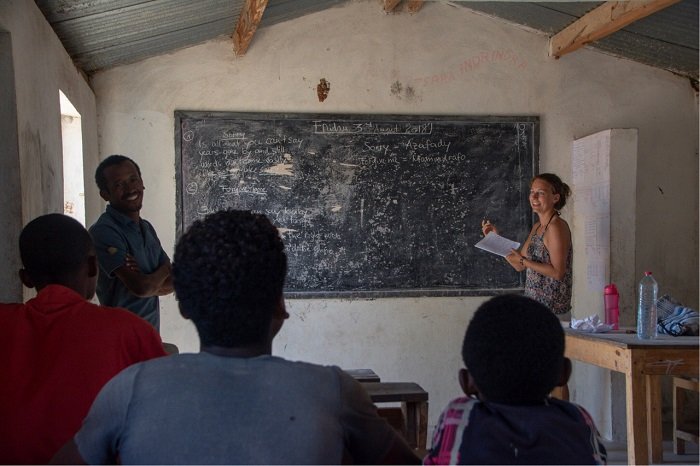
Leisure time
Of course, we also had free time while being a member of RD and we usually used it for relaxing, going to the local bar in Ifaty, going on fun dives, or going on weekend trips! There is a lot to do in the area!

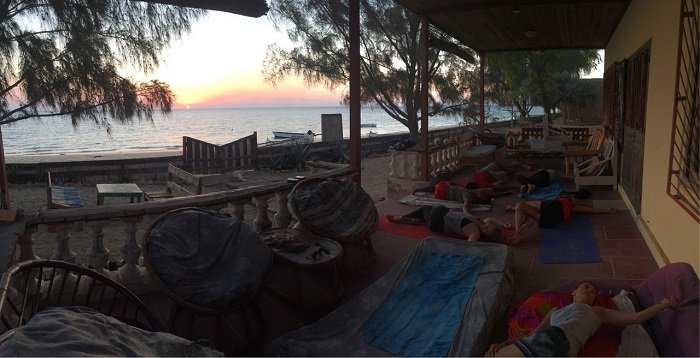

We really enjoyed our time at Reef Doctor and are proud to have been a part of the amazing work they do. It was a pleasure to meet so many motivated and awesome people there. The time we had in Ifaty went by way to fast!”

Blog: Ann-Kathrin Bott & Daniel Gaul
Photo credits: Dan Gaul, AK, Liz Pasea, Lucy Fisher and Margot Chapon




